Philips Lighting blogger Monique Cosineau talks to Canadian designer David Sasaki about his Light Fall design, which clinched second place at the 2013 CLU Foundation Contest. According to Cosineau, Sasaki's design was deemed by juries as being creative and functional, while addressing a a key part of cities: the vertical spaces. Below is the interview posted on Philips Lighting blog:
 |
|
David Sasaki and Light Fall team members Son Van Huynh and Chris Mudiappahpillai. (LEDinside/Philips Lighting) |
Tell me about yourself, your career and your education.
My name is David Sasaki and I’m a Project Architect currently practicing at the architectural firm ARK located in the city of Toronto. I have received My Master of Architecture from the Faculty of Architecture, Landscape, and Design at the University of Toronto in 2008 and I have an undergraduate degree in Engineering. My personal interests include the study and understanding of light and the exploration of the intersection of Film and Architecture.
My colleague Son Van Huynh received his Bachelor of Science and Master of Architecture Degree from the University of Toronto, and is currently completing his PhD in Art History and Visual Culture at York University in Canada. The intersection of memory, place, and architecture lies at the heart of his research and work. Huynh is a project designer for architectural office ARK in Toronto and holds a Joseph-Armand Bombardier Canada Graduate Scholarship by the Social Sciences and Humanities Research Council of Canada (SSHRC).
Christopher Mudiappahpillai believes that Design can make the world a better place, and that every problem should be critically considered – “good enough” is not an option, and settling for less usually ends up costing more than the solution is worth in the long run. He works at The Working Group, where he focuses on facilitation, with both designers and developers, as they solve customer problems. Christopher graduated from The University of Toronto, where he studied Philosophy.
Where does your interest in lighting design come from?
My interest in lighting design is inspired by my preoccupation with both natural and artificial light and the exploration of their relationship and individual properties. I believe that an intimate understanding of light is paramount to meaningful architectural design.
Why did you choose to participate in the Socialight contest?
The Socialight contest was of particular interest as it dealt with both light and future urban projections. It was an opportunity to speculate on the consequences that future urban conditions will have on the urban population and light access within this context.
 |
|
David Sasaki's Light Fall design. (LEDinside/ Philips Lighting) |
Can you share with us your initial idea behind this concept of Light Fall and what is the social aspect of this project?
The initial idea for Light Fall, came from studying the relationship between the ever rising skyline and the depth that it allows direct sunlight to penetrate into the urban fabric. As vertical forms of future urban centres continue to grow both in height and concentration they prevent direct sunlight from reaching the ground plane and cast the dwellers below into perpetual shadow. Disconnecting the urban population from the sun triggers health issues such as seasonal affective disorder, and lack of vitamin D production in the skin which may lead to depression and other health risks. Light Fall seeks to find resolution between the skyline and the penetration of sunlight in order to increase sun access.
Do you think that you proposal could become a reality?
This idea is already a reality in a sense as it is based on the idea of channeling or bending light. The bending of light can be accomplished by numerous materials and methods such as light pipes (fibre optics, flowing water), or as light travels from one medium to another. The major hurdle is the transmission loss that occurs as the light travels through the light pipe to its destination. This of course leads to other interesting questions and ideas such as light amplification and light storage.
Numerous products already exist today which employ fibre optic cables to transfer natural daylight to basement levels in buildings. In nature, the silica structure of the Venus Flower Basket acts to harvest ambient light from above and transport it to the ocean floor below, creating a dwelling place for seahorses – an example of light contributing to symbiotic relationships.
 |
|
David Sasaki's Light Fall design. (LEDinside/ Philips Lighting) |
What were your motivations for Light Fall?
The primary motivation for Light Fall is to return the shadow covered ground plane to a more humane condition by providing urban inhabitants with greater access to natural light – despite the seemingly unstoppable trend of vertical densification within urban centres. Greater access to light and (re)connecting the urban population to the rhythms of the sun will ultimately provide a healthier living environment.
Please tell us more about the operational aspect of your installation. How does it work?
Light Fall works to harvest, transport, and distribute the light of the sun to urban inhabitants living within vertical concentrations. Light is harvested from the roofs of buildings and partially from their faces receiving direct sunlight (i.e., the tallest of the high-rises) and transferred to the inhabitants below. Distribution points exist at various levels, not only distributing light to the public at grade, but increasing access to sunlight for those who live / work in the constantly shaded faces of surrounding high-rises. By channeling sunlight, this intervention reduces the need for artificial illumination and energy consumption and returns the temporal qualities of the sun.
This intervention essentially uses the idea of bending or channelling light around buildings to allow them to defeat their own shadows. If buildings were able to defeat there own shadows – that is, did not produce shadow – what would this notion do to our everyday urban experience?
How do you see lighting design evolving on a long-term basis?
The future of lighting design will have to consider the integration of natural and artificial lighting techniques. Sustainability and excess energy consumption will demand a return to more natural or sustainable forms of lighting. Hybrid lighting solutions will become important – those which harness the usefulness of the sunlight by day and switch to artificial supplements by night (or during cloudy conditions).
How do you see your professional career evolving?
:I would like to continue to develop ideas and solutions and eventually be in a position to one day unify my architectural career with my thoughts.














